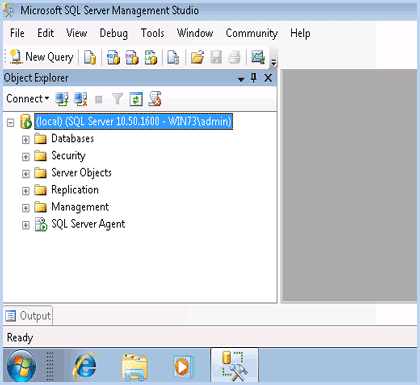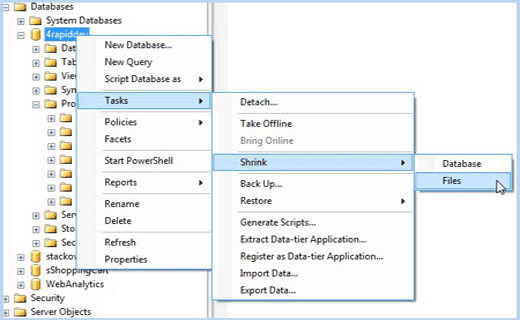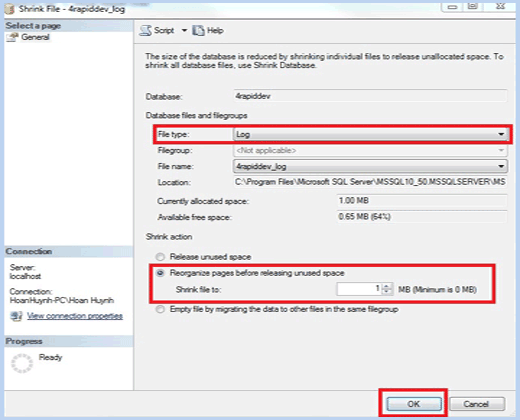- Log into Microsoft SQL Server Management Studio
- Right click on your database.
- Select Properties.
- Click on Options.
- Change the recovery model to Simple.
- Click OK.
- Right click on the database.
- Select Tasks > Shrink > Database.
- Click OK.
- Right click on the database.
- Select Properties.
- Click on Options.
- Change the recovery model to Full.
- Click OK.
- Simply using SQL Server Management Studio
- Through T-SQL Queries
SSMS Steps To Shrink a SQL Log File
- 1. Go to Start menu->All Programs-> SQL Server Management Studio->Object Explorer

- Click on Databases so that it Expands and Select the Database which you want to Shrink
- Then make a Right Click Go to Task-> Shrink-> Files.

- A "Shrink Window" appears Select File type i.e. Log and moves to downward and select "Reorganize Page before releasing unused page" and choose the Size for Log File.

If You Dont Want to follow above steps then Copy below query and paste in to Sql Query Window
SET ANSI_NULLS ON
GOSET QUOTED_IDENTIFIER ON
GO
CREATE PROC [dbo].[shrink]
@db_name SYSNAME = NULL
, @target_size_mb INT = 2
, @backup_location NVARCHAR(200) = NULL
, @backup_file_name NVARCHAR(200) = NULL
, @maximum_attempts INT = 10
AS
SET NOCOUNT ON
ALTER DATABASE [XXXXX] SET RECOVERY SIMPLEGOSET QUOTED_IDENTIFIER ON
GO
CREATE PROC [dbo].[shrink]
@db_name SYSNAME = NULL
, @target_size_mb INT = 2
, @backup_location NVARCHAR(200) = NULL
, @backup_file_name NVARCHAR(200) = NULL
, @maximum_attempts INT = 10
AS
SET NOCOUNT ON
SELECT @db_name = COALESCE(@db_name, DB_NAME())
DECLARE @logical_log_file_name SYSNAME,
@backup_log_sql NVARCHAR(MAX),
@shrink_sql NVARCHAR(MAX),
@checkpoint_sql NVARCHAR(MAX),
@db_id INT = DB_ID (@db_name),
@start_size_mb INT,
@final_size_mb INT,
@attempts INT = 0,
@recovery_model INT,
@recovery_model_desc SYSNAME,
@rc INT = 0 -- return codeSELECT @logical_log_file_name = name,
@start_size_mb = size / 128
FROM MASTER..sysaltfiles
WHERE dbid=@db_id AND fileid=2
SELECT @recovery_model = recovery_model
, @recovery_model_desc = recovery_model_desc
FROM sys.databases
WHERE database_id=@db_id
PRINT 'Starting size of [' + @db_name + '].['
+ @logical_log_file_name
+ '] is '
+ CONVERT(VARCHAR(20), @start_size_mb) + ' MB '
+ ' recovery model = ' + @recovery_model_descIF @start_size_mb <= @target_size_mb BEGIN
PRINT '['+@db_name+'] does not need shrinking'
END
ELSE BEGIN
IF @recovery_model != 3
AND (@backup_file_name IS NULL OR @backup_location IS NULL) BEGIN
RAISERROR ('Null backup file location or name. aborting.', 16, 1)
SET @rc = 50000
GOTO get_out
END
WHILE @attempts < @maximum_attempts
AND @target_size_mb < (SELECT CONVERT(INT, size/128) FROM MASTER..sysaltfiles
WHERE dbid = @db_id AND
name = @logical_log_file_name) -- not target
BEGIN
SET @attempts = @attempts + 1
IF @recovery_model= 3 BEGIN
SET @checkpoint_sql = 'use ['+@db_name+']; '
+ 'checkpoint'
PRINT @checkpoint_sql
EXEC (@checkpoint_sql)
END
ELSE BEGIN
SET @backup_log_sql = 'BACKUP LOG ['+ @db_name + '] '
+ ' to disk = ''' + @backup_location
+ CASE WHEN RIGHT(RTRIM(@backup_location), 1)='\'
THEN '' ELSE '\' END
+ @backup_file_name
+ CONVERT(VARCHAR(10), @attempts)
+ '.trn'''
PRINT @backup_log_sql
EXEC (@backup_log_sql) -- See if a trunc of the log shrinks it.
END
SET @shrink_sql = 'use ['+@db_name+'];'
+ 'dbcc shrinkfile (['+@logical_log_file_name+'], '
+ CONVERT(VARCHAR(20), @target_size_mb) + ')'
EXEC (@shrink_sql)
END
END
SELECT @final_size_mb = size/128
FROM MASTER..sysaltfiles
WHERE dbid = @db_id AND name = @logical_log_file_name
PRINT 'Final size of [' + @db_name + '].['
+ @logical_log_file_name
+ '] is ' +
CONVERT(VARCHAR(20),@final_size_mb)
+ ' MB'
get_out:
ALTER DATABASE [XXXXX] SET RECOVERY FULL
RETURN @rc
Exec shrink










